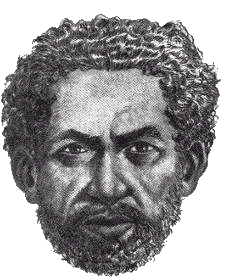Page traduced by
Fernando P. de Oliveira.

|
Antonio Francisco Lisboa, the Aleijadinho (The
Crippled One) is for sure the Brazilian artist from the Colonial Period best known and
most studied. Nonetheless, a few aspects of his life are still obscure. For starters, his
birthday is controversial. The date of August 29, 1730, written on his birth certificate
does not match data found on his death certificate, indicating his demise as of November
18, 1814, at the age of 76. He was a bastard and a slave, since born out of a wedlock as
the "love child" of the Portuguese architect Manoel Francisco Lisboa with one of
his slave girls. As afar as one
knows, Aleijadinho's artistic upbringing was probably the responsibility of his own
father, famous architect at the time,and of the draftsman/painter, Joao Gomes Batista.
Little is known about his forming years as a sculptor. Some biographers mention
names such as Francisco Xavier de Brito and Jose Coelho Noronha then renowned carving
artisans as his most likely mentors. |
Aleijadinho enjoyed the fullness
of life, a perfect health and the pleasures of a good table, in addition to the popular
dances in vogue at the epoch, together with his art, until 1777.
In 1772 he joins the brotherhood of Saint Joseph and in Rio de Janeiro in 1775, he fathers
a son with Narcisa Rodrigues da Conceicao, naming him Manoel Francisco Lisboa, after his
own father.
The year of 1777 was a splitting year in his
life, a time of illnesses. Until then his work reflected joyfulness, even some
cheerfulness. After that, especially towards the end, the artist's work becomes
somber, bitter and anguished.
In the words of city councilman for Mariana,
Joaquim Jose da Silva, quoted by Rodrigo Ferreira Bretas, " so much preciousness
stored in such a sick body that it must be taken everywhere and have the irons tied unto
him in order to perform his work". There are receipts of expenses incurred with
Aleijadinho's transfers which back up the above excerpt.
 Several surveys on the topic have been
published, but none Several surveys on the topic have been
published, but none
conclusive.Tancredo Furtado came to this inference: "leprosy is the only possible
affection to explain the mutilation (loss of the toes and some of the fingers), the
deformity (atrophy and arching of the hands) plus the facial disfigurement, all of which
earning him the nickname of Aleijadinho (The Crippled One).
Aleijadinho's fame and excellence of artwork reached immense renown after 1790 He
had left Vila Rica around 1788. By 1779 he was summoned to Sabara, where he got
commissioned for the works pertaining to the decoration, both
internal and external, of the Church of the Third Order of Carmo. For a period lasting
over 20 years, Aleijadinho was sought without cease by the majority of the colonial
villages in Minas Gerais, which would even fight, openly, for the artist's work, thus
making his life truly a rollercoaster.
There is a considerable artistic production left
by Aleijadinho, as it is evidenced in documentation kept in the archives. Receipts and its
corresponding accounting charges made in expense books are reliable historic sources,
leaving no doubt about the issue. The whole artistic lot of Congonhas offers abundant
material for research. The extent of the work made during 9 years in Congonhas demanded
intense cooperation of assistants, much more than at any other endeavor. By the end of his
days, seriously maimed due to the sickness, it would have been impossible for Aleijadinho
to leave behind such a valuable aggregate amount of art without help from his artisans.
In 1796, at the peak of a victorious artistic
career and regarded by his own contemporary folk as far superior to all the other artists
his peers, Aleijadinho starts in Congonhas his most significant cycle in his art. In less
than 10 years he produces a total of 78 statues, amidst which his greatest masterpieces. |

 Several surveys on the topic have been
published, but none
Several surveys on the topic have been
published, but none